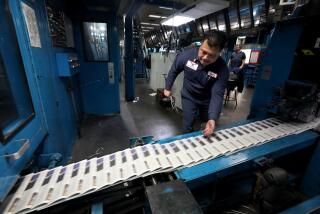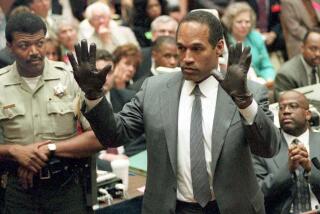The Tawdry, Tabloid Legacy of ‘Hard Copy’
Dearly beloved. Today, we come to bury “Hard Copy,” not to praise it. And while it’s never polite to speak ill of the dead--even those we really dislike--in its passing we feel obligated to point out what the show and its ilk have wrought.
Historians will note that “Hard Copy” and other tabloid TV newsmagazines flourished in the O.J.-crazed latter half of the 1990s--a period that has been to journalism what the reign of the emperor Caligula was to government.
Beyond practicing checkbook journalism by paying interview subjects, the show’s low-lights included being sued by Michael Jackson (the gloved one) for slander; returning runaway teens to dubious home situations just so it could tape the reunion; and intrusively stalking celebrities, only to buckle a bit when actor George Clooney led a boycott against a sister Paramount production, “Entertainment Tonight.”
In the course of its 10-year run, “Hard Copy” turned anchors Terry Murphy, Barry Nolan and Diane Dimond into just about the most repulsive things you could see in your living room with less than six legs. Though production ended in the spring, reruns of the program cease airing next week, three years after the death of its predecessor and fellow wallower in the tabloid ooze, “A Current Affair.”
These shows are survived by a television news business that, increasingly, looks and behaves just like them--reveling in slick graphics, hidden-camera “gotcha!” stunts, and stories of personal tragedy and mayhem at the expense of more sober and significant issues. Indeed, some would say the tabloids went the way of the dinosaur precisely because the Amy Fisher interviews and trailer-park killings they fed upon began winding up in the maws of the major networks.
Consider “Dateline NBC” and “20/20,” which have gradually incorporated techniques that were once the exclusive province of the tabloids, from adding eerie music to using the camera to provide a killer’s-eye view. Network newsmagazines, which have multiplied as programmers try to balance the cost of their prime-time lineups, also showcase more inconsequential segments about sensational crimes, contributing to a sense that violence in our society is more rampant than it actually is.
Maury Povich, who originally anchored “A Current Affair” and now hosts a self-titled syndicated talk show, maintains the network newsmagazines have “definitely dipped into what I consider talk-show topics,” focusing on intimate, personal “stories” that more prestigious news organizations once shunned.
With all those prime-time editions to fill each week, Povich noted, “What are they going to do, Turkish earthquakes for 15 hours? I don’t think so.” As NBC and ABC keep pilfering from the talk-show menu, he added, “I think it just gives us a little more legitimacy.”
Or, one might argue, the networks less legitimacy. Yet if this seepage of the tabloid/talk-show mentality into mainstream news has met with hand wringing among news purists and a collective yawn from the public, there is a third group affected by it--namely, broadcast journalists themselves.
Ken Lindner, a television agent who represents such marquee clients as the “Today” show’s Matt Lauer, ABC’s Elizabeth Vargas and “Later Today” host Jodi Applegate, recently wrote a book titled “Broadcasting Realities.” In it, Lindner indicates he encounters considerable unhappiness and frustration among broadcast journalists--especially those tethered to low-rated stations, who feel their bosses lack ideals “and would do anything, cover anything, and would hire anyone in order to get a boost in their ratings.”
Lindner (who wrote the book essentially as a primer on TV news and intends to donate a portion of his royalties to the American Red Cross) expressed sympathy for news executives, who--facing corporate pressures to make their operations profitable--often adopt the production values and style of tabloid shows because there is a demonstrable audience for such fare.
“Most of these people want to do the noble thing, to go home and say, ‘We informed people today.’ It’s just if they have a consultant saying, ‘You’ve got to spice things up’--it’s a problem,” he said.
At the same time, Lindner noted, some of the people employed by those news organizations “are saying to me, ‘I’m just tired of covering car chases and crime. I’ve just had it.’ ”
Perhaps foremost, the tabloids knew how to generate attention--something network and local news outlets are compelled to do amid an explosion of media options, with three all-news channels and innumerable talking-head shows screaming about headlines instead of analyzing them. In this environment, reporting on meat-and-potatoes issues such as school board meetings and health-care reform has a hard time competing with “caught on tape” segments and clandestine footage of Leonardo DiCaprio, captured cavorting in the surf via a telephoto lens.
Lines between tabloids and more traditional news outlets have further blurred thanks to the flow of talent among them, from NBC giving Geraldo Rivera a home to onetime “Today” host Deborah Norville landing in an anchor chair at “Inside Edition.”
Lindner maintains there is still room for solid reporting even at local TV stations, citing KCBS-TV’s exposure of unsanitary restaurant conditions as proof that strong investigative work--well promoted and packaged--can deliver strong ratings.
Then again, the lessons of that achievement were mixed at best, given that the KCBS general manager who spearheaded the commitment to such reporting, John Culliton, was let go last year, unable to satisfy the bottom-line demands of CBS’ corporate hierarchy.
To be fair, a lot has happened since the days when the ticking clock on “60 Minutes” represented the flashiest visual effect one was likely to see in news programming. Entertainment value and storytelling now rule the day, and nothing will ever put the genie back in that little bottle.
Povich is probably right, then, when he suggests that the demise of “Hard Copy” is merely part of a cycle. Calling the tabloid “a classic American tradition,” he predicts a program will come along in the next year or two and renew the genre, taking the tabloid in a new direction and viewers by storm.
Until that day arrives, providing TV critics some high-profile new whipping boy, we bid an old friend farewell and erect the following, fitting tribute: “ ‘Hard Copy,’ 1990-99. R.I.P. Gone . . . but Your Stench Will Go On.”
*
Brian Lowry’s column appears on Tuesdays. He can be reached by e-mail at brian.lowry@latimes.com.
More to Read
The complete guide to home viewing
Get Screen Gab for everything about the TV shows and streaming movies everyone’s talking about.
You may occasionally receive promotional content from the Los Angeles Times.






